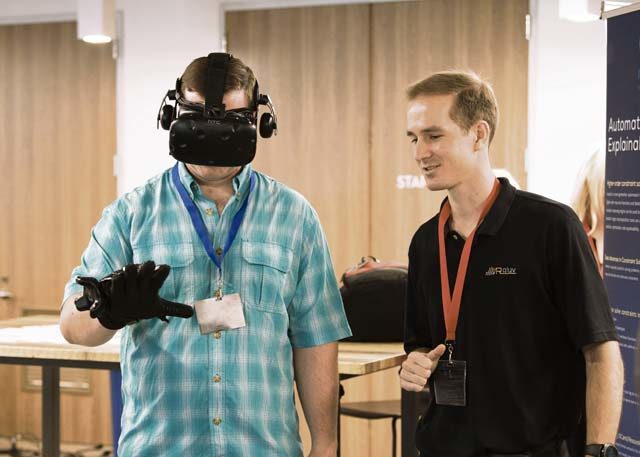by Charles Pope
Secretary of the Air Force Public Affairs
The Air Force’s near obsession with innovation is well known and deeply rooted. The service’s vision statement, after all, says, “Powered by Airmen, fueled by innovation.”
Yet finding and nurturing novel ideas and turning them into real world, everyday products and policies that benefit the Air Force is no easy matter in a global organization with 685,000 Total Force men and women.
That’s one reason more than 400 people converged in Austin, Texas, Aug. 14-15, for an event the Air Force dubbed “Spark Collider.” Over those two days, Airmen with potentially good ideas mixed with officials from qualified small businesses who are in a position to help develop the ideas and bring them into reality. They also interacted with representatives from the Air Force’s major commands, from assorted program offices and other parts of the Department of Defense.

In Air Force speak, the Spark Collider “will accelerate the matching of Air Force problems with viable solutions” by being equal parts speed dating, tech showcase and pitch sessions. The Air Force’s effort to innovate is part of a central tenet for defending the United States as outlined in the National Defense Strategy.
“To succeed in the emerging security environment,” the document states, “our department and joint force will have to out-think, out-maneuver, out-partner and out-innovate revisionist powers, rogue regimes, terrorists and other threat actors.”
“The Spark initiative helps Airmen create pathways to bring real solutions to their day-to-day pain points,” said Maj. Tony Perez, who directs Spark activities for AFWERX, the Air Force’s in-house operation to foster grass-roots innovation at the base level.
The Spark Collider combines that overarching goal with more specific and focused collaborations. “At the Spark Collider, Airmen get to have honest conversations with nontraditional vendors who are contract ready and whose solutions can be executed rapidly,” Perez said.
“Through a ‘team-of-teams’ approach and the efforts of multiple program offices, Air Force Acquisitions, the Air Force Small Business Innovation Research program, various major commands and AFWERX, we are bringing tomorrow’s tools to the warfighter today,” he said.
While impressive by itself, the event in Austin was only the latest in the “spark” family of initiatives from the Air Force. All of them are designed to foster, incubate and bring to market innovative ideas making the Air Force more effective, more nimble and more likely to surpass mission requirements.
There is Spark Tank, the highly produced, ready-for-TV effort that features good ideas and products from Airmen worldwide in an elimination format to find a single winner. The 2019 winner, Master Sgt. Jonathan Maas of the 52nd Fighter Wing, Spangdahlem Air Base, Germany, was on stage with then-Secretary of the Air Force Heather Wilson, Air Force Chief of Staff Gen. David L. Goldfein, Chief Master Sergeant of the Air Force Kaleth O. Wright and celebrity judges Mark Cuban and George Steinbrener IV.
There are also Spark Cells, which are a smaller but thriving collection of “innovation centers” at 47 Air Force facilities. These cells encourage Airmen to act on their idea by providing a hub and clearinghouse where they can test and refine their idea, get information for how to take next steps and benefit from crowd-sourced experience and wisdom. All of it is designed to identify ideas and bring legitimate ones into reality.
The Air Force has also established an ideation website where any Airman can register, submit an idea and receive feedback, advice and insights to refine and push the idea forward.
All of them play an important role.
“It’s no overstatement to say that brilliant ideas combined with trailblazing Airmen make today’s Air Force the most lethal and the best in the world,” said Air Force Vice Chief of Staff Gen. Stephen W. Wilson. “These programs are crucial to our success since the next great idea, the next big innovation can emerge anywhere, at any time, from any one of our Total Force personnel. We must be ready for those moments.”
Maas’ winning idea in the Spark Tank competition is one example. His big idea was finding a way to provide continuous power to chemical detection units that previously required frequent battery changes. He is currently at the AFWERX Las Vegas Hub building his prototype of the renewable energy source that is slated to save more than 1 million dollars in batteries and more than 10,000 hours of tedious work for Airmen each year.
His idea beat five other finalists and also illustrated an important concept — being innovative in a way that directly improves the Air Force’s ability to succeed does not always have to be big and flashy.
“The Air Force has always been known for breakthroughs,” Wilson said. “It was an Air Force pilot who broke the sound barrier. We were the first service to use stealth technology and drones. Those are well known.
“Lesser known, but no less important, are the smaller innovations that together make us more lethal and ever ready to successfully defend the country and its interests,” he said. “We are indeed fueled by innovation.”


